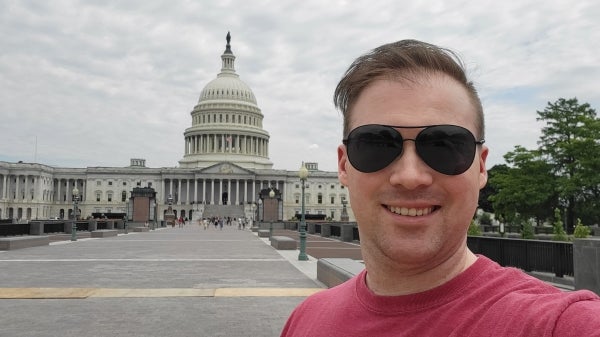Outstanding grad credits ASU program for becoming a fire captain at 24

Oliver Silva, fall 2019 outstanding graduate, interdisciplinary programs., Watts College of Public Service and Community Solutions
Editor’s note: This is part of a series of profiles for fall 2019 commencement.
For a firefighter to attain the rank of captain usually takes several years, often a decade or two, of dedicated service.
At age 24, Utah Air National Guard Staff Sgt. Oliver Silva — make that Fire Captain Oliver Silva — credits his graduate studies at Arizona State University as what set him apart from his colleagues.
Silva is captain in the fire department at the 801,505-acre U.S. Army Dugway Proving Ground in the northwestern Utah desert, about 50 miles southwest of Salt Lake City. He is receiving his master’s degree in emergency management and homeland security offered by ASU’s Watts College of Public Service and Community Solutions, and is the Watts interdisciplinary programs’ fall 2019 Outstanding Graduate.
“I heard from fire chiefs and had a lot of mentors who made it clear that the way the fire world is going, they want educated people.It was one of those things they highly recommend to set you apart from other individuals, and that is what I wanted to do.”
— Oliver Silva
“I consider it one of my greatest achievements,” he said of his becoming captain. “Most career firefighters take at least 20 years to get to that level.”
Silva, from Mount Pleasant, Utah, said he realized he wanted to study emergency management after people he respected in the field informed him that employers were increasingly seeking applicants with college credits.
“I heard from fire chiefs and had a lot of mentors who made it clear that the way the fire world is going, they want educated people,” Silva said. “It was one of those things they highly recommend to set you apart from other individuals, and that is what I wanted to do.”
He said he was pleasantly surprised to find many of his ASU courses were directly related to his career, from learning how to write policies to directing programs.
Today at Dugway, he’s in charge of all department preparedness and response to Chemical, Biological, Radiological, Nuclear and High Yield Explosives, or CBNRE for short.
Silva said he chose ASU because of its renowned program for emergency management and homeland security, ranked No. 1 by U.S. News & World Report. “It’s also one of the best military-friendly schools — also a plus,” he said.
The online program he undertook was easy to fit into even Silva’s complicated firefighter schedule: 72 hours on, 96 hours off. He also has time to volunteer at his community's local fire department and ambulance service.
He said one of the best aspects of online study was interacting with other students with different preparations.
“Everyone had different knowledge and experience from different organizations and different parts of the world,” he said. “Someone would be focused on earthquakes and hurricanes, others on snow, depending on the different parts of the nation they were from.”
Silva said his post-graduation plans are much the same as they are now.
“I’m going to stay where I am, and keep working on improving myself as a captain and leader,” he said.
If offered $40 million to solve one problem in the world, Silva’s answer was clear and straightforward, the kind you might expect from a dedicated fire captain: “I’d help improve my community emergency response services to keep our community safe.”
More Sun Devil community

ASU grad finds purpose in public policy and service
When Bryson Jones took an AP government class back in high school, he found himself fascinated by the machinery of government and…

First-generation college student dedicates career to improving students' experiences in STEM
When Erika Nadile was a kid, she dreamed of being the first in her family to go to college. But she wasn’t sure that dream was…

Foster youth and the unhoused find champion in MBA grad
Brodie Butler began her academic career as a premedical student, but it wasn't long before she discovered her true passion:…